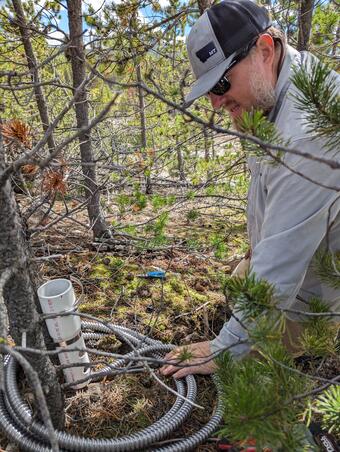Listening for hydrothermal activity (and more!) in Yellowstone
Continuous infrasound (low-frequency acoustic energy) monitoring is now established in Yellowstone. And the method is detecting activity that goes beyond geyser eruptions.
Yellowstone Caldera Chronicles is a weekly column written by scientists and collaborators of the Yellowstone Volcano Observatory. This week's contribution is from Michael Poland, geophysicist with the U.S. Geological Survey and Scientist-in-Charge of the Yellowstone Volcano Observatory.
Infrasound refers to low frequency acoustic energy. For the audio enthusiasts out there, the specific frequency range of interest is 0.1–20 Hz, which is below the range of human hearing (typically 20–20,000 Hz). Even though infrasound is not something humans can hear; this sound energy can be important for monitoring processes that occur within Earth’s atmosphere.
Infrasound travels efficiently through the atmosphere, experiencing very little atmospheric absorption or scattering compared to higher-frequency energy. This means that infrasound can travel great distances and still be detectable. As a result, infrasound is an important component of the International Monitoring System (IMS), which is intended to detect nuclear tests. Nuclear explosions, even underground, create significant low-frequency sound waves that can be detected even thousands of miles away from the explosion source.
If infrasound is great at detecting nuclear explosions, you might expect that it is also exceptional for detecting volcanic explosions. And you would be correct! Infrasound monitoring is widely used to monitor volcanoes. Because infrasound energy travels easily through the atmosphere, monitoring systems don’t have to be right at the volcano of interest. In fact, in Alaska there are just a few infrasound monitoring stations that track activity along the entire chain of volcanoes in the Aleutian Islands, which stretches about 1,100 miles (1,800 kilometers) across the North Pacific!
Ideally, infrasound monitoring is done by arrays of 3 or more instruments that are located in close proximity to one another. By installing at least three instruments in a triangle-shaped array, it is possible to measure the direction from which infrasound signals originate. This is because sound waves travel at a relatively slow speed of 761 miles (1225 kilometers) per hour. That might seem fast, but compare that to seismic waves, which travel through the Earth at up to 3–5 miles (5–8 kilometers) per second! At these slower speeds, infrasound waves arrive at each station in an array at slightly different times. By comparing the arrival times between stations, it is possible to tell the direction from which the sound originated. If the infrasound energy is recorded on more than one array, the actual location of the sound’s source can be triangulated.
Prior to 2023, infrasound recordings in Yellowstone were either temporary deployments designed to study specific geysers or were single microphones that could not measure the direction from which the sound originated. In September 2023, however, the first continuous, permanent, 3-sensor infrasound array was installed in Yellowstone—in Norris Geyser Basin, specifically. The station paid immediate dividends, tracking activity at Steamboat Geyser. Infrasound energy from those eruptions is detectable continuously for several hours, indicating a very energetic source.
The new infrasound station also recorded a powerful “boom” sound that lasted nearly 1 minute on the afternoon of April 15, 2024. This event was associated with a small hydrothermal explosion in the area between Porcelain Basin and Nuphar Lake. The explosion was unwitnessed, but it left a small crater about 10 feet (about 3 meters) across surrounded by an area of warped and disturbed ground. Infrasound therefore provides a powerful means of detecting hydrothermal explosions that might otherwise go unnoticed; this is why the technique is an important component to the Yellowstone Volcano Observatory’s monitoring plan for the Yellowstone region.
The Norris infrasound station did not detect any sound from the impressive hydrothermal explosion at Biscuit Basin on July 23, 2024, which was 18 miles (29 kilometers) from the station. The sound from this event seems to have been muted, indicating that in Yellowstone we can’t count on just one or two infrasound stations to cover the entire region. Instead, multiple infrasound arrays might be needed to track activity across the numerous geyser basins in Yellowstone National Park, including those in remote backcountry areas.
Geyser eruptions and hydrothermal explosions aren’t the only signals that produce infrasound in the Yellowstone region. On the evening of May 3, 2025, people in Canada, Utah, Montana, Idaho, Washington, and Wyoming observed a bright fireball in the sky, and those in the Yellowstone region reported a loud booming sound. This bolide, as such meteors that explode in the atmosphere are sometimes called, was filmed by several witnesses in the region. And as you might expect, the infrasound station at Norris Geyser Basin clearly detected the event!
Even though infrasound is below the frequency of human hearing, the data can be “sonified”—meaning that data are converted to audible sound. By doing that to the May 3 bolide signal, you can “hear” the explosion (or, at least, the infrasound associated with the explosion) even if you weren’t in Yellowstone that night!
The Yellowstone Volcano Observatory hopes to deploy additional infrasound stations in the region in the coming years. Stay tuned as we make use of this monitoring technique to better “hear” geyser eruptions, hydrothermal explosions, and the occasional exploding meteor!



